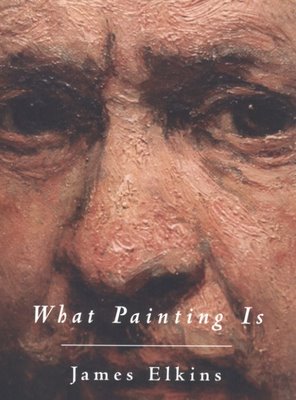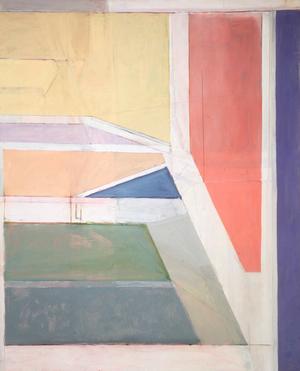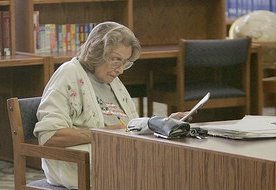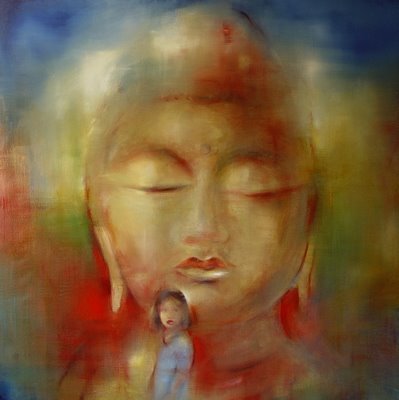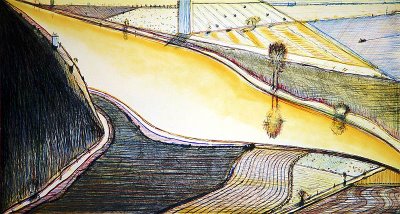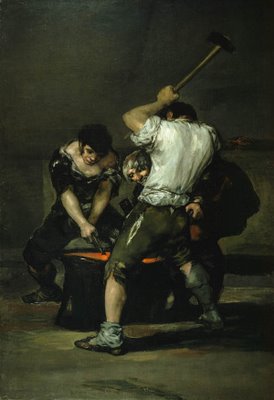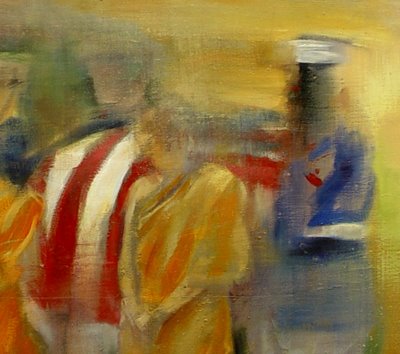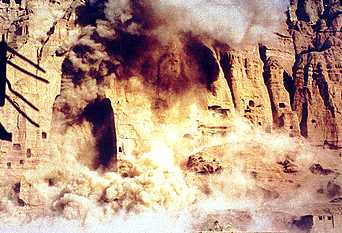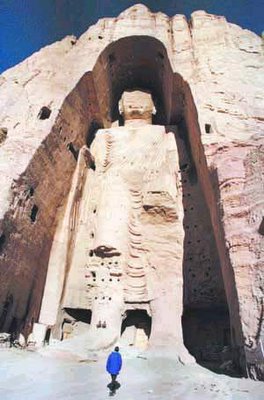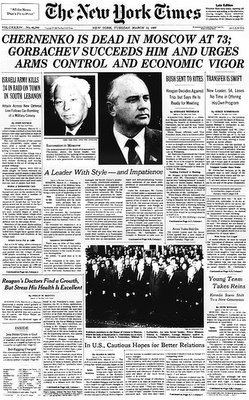
"A Walk with Ganesh"
Gregg Chadwick, 72" x 84" oil on linen 2005
My brother,
Kent Chadwick, is a Seattle writer and recently finished a poem inspired by the painting above:
"A Walk with Ganesh"
Obediently, I begin, but it is a curious
way to experiment with no design
and venture out in thought alone.
It is my father who has traveled to where elephants
wander, to where they’re worked and tended.
It is my brother who has breathed the red
dust of Bangalore, who was told
by a Bombay cab driver,
“Ganesh was just in my car!”
At home I know just what I read—
that he broke off a bit of his tusk
to take dictation, to copy
down at divine speed
the inspired, sculpted rush
of Ved Vyasa’s verse
creating the Mahabharata.
Oh, to compose as swiftly
as a god can write!
Oh, to out sing one’s breath!
Obediently, I begin a journey
measured in mouse steps—
a journey inside—to that seam
between animal and god, those stitches
holding our incongruousness together.
A seam like the one his mother’s
husband made with a sword:
Shiva, angered, striking
off the head of this unknown lad
who blocked the door to the bath,
the boy Pavarti made
from the sluff of her body herself
to guard her door, her honor.
Remorseful, Shiva sent
his retainers to find another.
They found an elephant by a stream,
sacrificed the young bull—
it’s blood flowed down to the water,
dyeing the fair stream—
and they carried back its proud
head of tusks and trunk,
which Shiva joined to the lifeless
body of the boy, reviving
him, making him god of beginnings,
Ganesh, remover of obstacles,
Ganesh of a mother’s love.
How swiftly we pull our swords;
how often cry out in sorrow.
Obediently, I follow Ganesh
into my head, my memory, my past.
He knows where he is leading, with no hesitation
takes me back to the bare
hills of Southern California:
their sage and tumbleweeds,
tan grass alive
with beetles, horned lizards,
red diamondbacks.
Vultures soaring and seeking
over the arroyos; the chaparral baked
in the sun’s blue kiln;
the wind’s warm fragrance
dryly whispering, “Thirst.”
“Why this place?” I ask.
“Isn’t this your imagined golden land?
What better place to see the story you are to sing?”
To sing?
Oh that this god would grant sweet lyrics.
On a path of sandy loam,
quartz, fool’s gold,
we crest a hill of oaks
and see below us Combat Town.
The idylls forming in my head
of surf and sand and love
disappear with the smell of spent
shells and smokeless powder.
This is the place we played as boys,
among the cartridges, K-ration
tins, ammo boxes,
scarred earth and walls,
mimicking our fathers’ skills
in killing the enemy and saving
their own. This is where we acted the lucky
hero whose M-16
clip never empties, who captures
the flag and comes back
home unscathed, victorious.
This was Combat Town circa
1963
arranged as a Vietnamese hamlet
with sweeping roof lines,
open air market,
even a pagoda, which is where Ganesh heads,
a pagoda without sutras, built
not to house a holy scripture
but for training in combat tactics,
hollow like all the buildings in this town.
On the ground floor Ganesh
sits his great body
into position, folded supplely
for meditation, his elephant head
echoed in the carvings on the pillars
of animals of power—elephants
and tigers—verisimilitudes
the Architect had insisted on.
What powerful tremors,
what earthshaking silence
flows from the meditation of an enlightened one.
I look out the empty windows
of the bullet-pocked pagoda
and see Combat Town
fill with young recruits
fumbling with their rifles, confused
on how to move, how to follow orders
that their drill instructors shout,
blushing when the war game
officer marks their helmet:
“You’re wounded. You’re dead. You’re hopeless.”
And time accelerates around Ganesh:
the recruits run through their drills,
day upon day losing
their awkwardness, reflectiveness, weakness,
becoming stronger, fiercer, obedient,
ready to aim and fire.
The anger, fatigue, and repetition
carve a soldier’s instincts
into their psyche, setting the triggers
that when needed will help them kill
and survive, save their buddy,
bring their unit honor.
Then the rounds’ sound changes
to live firing. It’s Vietnam
before me and those same recruits are blooded warriors
now moving through a hamlet safely
separated, poking the dead,
silencing any hut that returns
fire, questioning the headman
in pidgin about when the V.C.
came and where they ran to, believing
only half of what he says or what they see.
And when their patrol moves on, the local
Viet Cong lieutenant
climbs out of a tunnel
below the headman’s home
with the men and women from his squad
he’s saved and they slip away.
The Marine patrol comes
back through the hamlet in another week.
The corporal on point spots
the mine, signals a halt.
The men crouch anxiously.
With no explosion to begin their ambush
the hidden Viet Cong
start firing separately,
yet are killed quickly by multiple
streams of automatic fire.
One of their rounds, though, tears
off the corporal’s jaw—a gaping
wound where his mouth had been.
The sergeant pulls him to cover
by his ankle, his broken face
dragged oozing over the dirt.
His buddy crawls to him and stabs
syringes of morphine into his leg,
wraps his head with gauze.
When they finally secure the hamlet
they force the villagers out of their homes
and huts and fields, push
them out on the road carrying chickens
and children, leading their buffalo,
warning them not to turn back—
“Go! Go! Don’t look!”—
as a Thunderchief delivers
the napalm strike exploding
as a white fireball
burning everything they’ve known.
“It is a great sin,” Ganesh says,
“to ever imagine destruction as a cleansing.”
Through the acrid smoke I watch
the Architect directing changes,
reshaping Combat Town
by blueprint, desperate
for a stratagem that will win the war:
strategic hamlets, truces,
carpet bombing, mining
Haiphong Harbor, interdiction,
Vietnamization, invading Cambodia.
But every advantage leads to losses
and the helicopter evacuation of Saigon.
Combat Town quiets down
for a season. But then new blueprints
are drawn and the pagoda we are in becomes
a Central American church
and wars later is rebuilt to be a mosque.
And the weapons the recruits learn
become smarter and more deadly, as do they.
And when Ganesh rises from his meditation,
and I am ready to leave this dream,
he chides me and leaves me there to stay,
saying, as he rides his mice away,
“This is your story, no?
America’s story.
A story of continuing war.”
— Kent Chadwick




